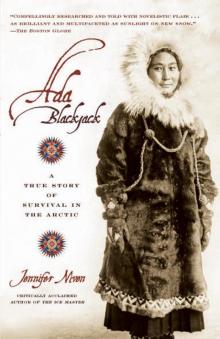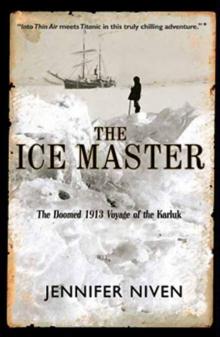- Home
- Jennifer Niven
Ada Blackjack: A True Story of Survival in the Arctic Page 2
Ada Blackjack: A True Story of Survival in the Arctic Read online
Page 2
And in towns across America, Chautauqua week became the most important week of the whole year. Flyers were pasted to store fronts, shop windows, and lampposts. Banners waved proudly from automobiles and buggies.
Called “the most American thing in America” by Teddy Roosevelt, the Chautauqua circuit was a touring college of sorts, bringing art, education, and issues to people who might never have been exposed to them otherwise. Seven days in one place, five days in another, it always took place in small towns in the heartland, where people were, for the most part, cut off from the outside world. Four-tent circuits traveled one route, and seven-tent circuits traveled another. Lively programs offered variety in morning, afternoon, and evening shows for each day of the tour; then the entertainers packed up and moved on to the next place and started over again. To the performers, the routine often became tedious, but to the audiences of each town they visited, Chautauqua was magic every time.
Photography was still a novelty in many small towns; movies and radio were in the infant stage; and there was no television. For those who never left home, Chautauqua exposed them to art, literature, political thought and theory, social issues, and geographical wonders. For the very first time, they might see a photograph or lantern slide of the North Pole, the African desert, or the pyramids of Egypt.
It was the seven-tent Chautauqua that pulled into New Braunfels, Texas, in April 1921. Seven days filled with splendid attractions! Twelve concerts! Ten lectures! A big play production! The air was filled with the noise of people and automobiles and equipment as the smart, perfumed women and handsome, mustached men stepped off the train or out of sleekly lined motor cars and had the look of Somewhere Else.
The residents of New Braunfels greeted the visitors with a parade, which was how they had celebrated the start of each Chautauqua since April of 1917, the first year the tour had come to town. People from neighboring cities which weren’t lucky enough to have been chosen as stopping points traveled in for the show.
Local boys lined up for a chance to set out folding chairs or pound nails into platforms or raise the gigantic brown tents that were Chautauqua’s trademark. Under those tents—each of which could hold two thousand people—presidents and politicians, opera singers and musicians, actors, humorists, contortionists, adventurers, authors, and orators would perform or speak to the people who had worked hard to set aside extra money to purchase a ticket—75 cents for a day or $2.50 for the whole week.
On opening night, audiences were treated to music, dancing, and speeches. The following afternoon they might see barbershop quartets, magicians, gymnasts, acrobats, and bands. Children rushed out of school at three o’clock and ran to catch the matinees. In the evening, after most of the young people had been put to bed, there was a melodrama, with a cast of six or so, and music again. Then there was the backbone of the Chautauqua circuit—the inspirational and informational lecture, a different one every evening, on topics ranging from women’s suffrage to the environment. On the third night the keynote speaker—the star of the tour—would appear.
That spring of 1921, when the highly anticipated third night arrived, the audience in New Braunfels, Texas, enjoyed a musical prelude. Then it was Fred Maurer’s difficult mission to warm up the crowd. The twenty-eight-year-old had given up his job filling orders and overseeing inventory at the Goodyear Tire and Rubber Company in Akron, Ohio, to take on the thankless position of being the opening act for noted explorer and anthropologist Vilhjalmur Stefansson, who, as a headliner, commanded $1,000 each week for his speeches.
Maurer had not always been an office worker sitting behind a desk. Seven years earlier he had returned from the Arctic a hero. In spite of his piercing blue eyes and chiseled jaw, his thick blond hair, broad shoulders, and stocky, football player physique, Maurer didn’t look like an adventurer. The beloved and pampered youngest of ten, he was introverted, soft-spoken, stoic, reserved, and cool. He was a kind man who hated conflict and raised voices, and he didn’t frequent beer halls or chase women. He was an upstanding member of his small Ohio community. He belonged to the Masonic Lodge of New Philadelphia, the Delta Upsilon Fraternity of Marietta College, and the Geographical Society, and was a devout congregant of the First Church of the Reformed.
He had left home at age eighteen to pursue his dreams of adventure. In San Francisco he signed up as deckhand on a whaling ship named the Belvedere. In March of 1906 at Herschel Island, just off the northern coast of Canada, Maurer met Vilhjalmur Stefansson for the first time when the explorer came aboard as the honored guest of the ship’s captain. A noted explorer, ethnologist, anthropologist, author, and orator, Stefansson was a man who inspired awe in young boys who dreamed of the North. Maurer was no exception, having read about him in the papers and heard his name for years.
It was not until 1912, when Stefansson was planning his highly ambitious 1913 Canadian Arctic Expedition, that Maurer was to meet up with him again. In addition to scientific and geographic work, the primary goal of the expedition was to discover new lands. Stefansson staunchly believed there was an uncharted, undiscovered continent at the top of the world, and he intended to find it. The Belvedere’s skipper recommended Maurer to Stefansson for work on the expedition’s crew. Impressed by Maurer’s poise and intelligence, Vilhjalmur Stefansson hired him as fireman.
But the 1913 expedition proved a disaster. After the expedition ship Karluk became trapped in an ice floe just a month after setting sail, Stefansson abandoned most of his company to continue his journey on foot, crossing over the ice to the Alaskan mainland. For months, the ship drifted to the northwest until, five months later, the Karluk sank, stranding scientists and seamen far out in the polar ice. Maurer joined his fellow crewmen in cursing their absent leader. After the ship’s captain led the abandoned group one hundred miles across treacherous ice to formidable, desolate Wrangel Island, Maurer and the others again cursed Stefansson while they struggled to eke out an existence. Many of the men died—eleven of the original twenty-five— but Maurer survived somehow and spent six months on Wrangel Island, two hundred miles northeast of Siberia and four hundred miles northwest of Alaska, before he was rescued.
“It seemed like entering into another world,” Maurer wrote when he returned home to Ohio afterward. “The daily mail, the roar and rumble of traffic... seemed so new. The great silent north was far behind.” After he set foot once more on American soil, he found that everything seemed novel and interesting. He became fascinated with billboards and signs, and had a strange desire to purchase everything he saw. For two years, he had lived like a prisoner of the ice, the cold, and a barren and unfriendly island, and once home he reveled in his newfound freedom. He let himself buy what he wanted and eat what he wanted and he slowly began to feel like himself again. But not completely.
After returning from Wrangel Island, Maurer felt partially lost, partially empty, and increasingly restless. There was a void inside him which he tried to fill by joining the army during World War I and through speaking and writing about the Karluk expedition. None of it helped to heal the old wounds or ease the restlessness Maurer felt deep down, in a place so private he rarely revealed it to anyone.
Gradually, he began to forget his resentment toward Stefansson and his gratitude at being home and safe, warm, and well fed. He began to yearn for adventure again, just as he had when he was a teenager and longing to go to sea, and he became obsessed with study, spending his spare hours schooling himself on the Arctic. It was Stefansson who suggested he join the Chautauqua tour.
“Can you give me definite information as to prospects of going north, anxious to...but should know soon before close of Chautauqua season so can make plans accordingly,” Maurer had telegraphed Stefansson before joining him in Texas.
“Sorry no chance to go north this year but think there will be next year if you still want to go,” Stefansson had replied.
Actually, it was a privilege and an honor to be a part of Chautauqua and to speak to people about his polar adv
entures, and Maurer also liked to help out in any other ways he could, whether running the projector or setting up and taking down tents. He had signed with Chautauqua to spend the summer lecturing on the Fours, as they called the four-day circuit, which was something to be proud of. No warm-up act—just Maurer himself as a main attraction.
But here on the spring tour, as the opening act to Stefansson, it was disheartening to see the restless looks on the faces in the audience, the glances at wristwatches to check the time, the yawns behind the paper fans that fluttered constantly under the oppressive heat of the tent. Maurer always drew a quarter of the crowd that Stefansson attracted with his famous name and reputation, and although a good many of that number were admiring young ladies, eager for a glimpse of Maurer’s intense blue eyes, golden hair, dimpled chin, and matinee idol looks, it only served as a frustrating reminder to the want-to-be explorer of just how far he needed to go to grow into his hero’s shoes.
Why should any one want to explore the Arctic?
Vilhjalmur Stefansson knew how to work an audience, and no audience was more willing to listen to his promise of the Great White North than the ones he found in the small, dusty, uncultured towns on the Chautauqua tour.
The land up there is all covered with eternal ice; there is everlasting winter with intense cold. The country, whether land or sea, is a lifeless waste of eternal silence. The stars look down with a cruel glitter, and the depressing effect of the winter darkness upon the spirit of man is heavy beyond words. This...is the current picture of the Arctic, and this is... what we have to unlearn before we can read in a true light any story of Arctic exploration.
His words packed a punch. It was as if he knew what people wanted to believe, at their deepest level, and he gave it to them forcefully, assuredly, conclusively. He created dreams and ideas, and, some would argue, had even created himself. Born William Stephenson in 1879 in Manitoba, Canada, he had changed his name to Vilhjalmur Stefansson in college because he thought it sounded more in keeping with his Icelandic heritage and because it seemed a more fitting name for a future explorer.
In order to understand the Arctic explorer and his work we must understand the Arctic as it really is.
At forty-one, Stefansson was effortlessly elegant, polished, articulate, and brilliant. With his fair, wavy hair, delicate features, and slight build, he did not look the part of explorer. But he possessed great charisma born out of enormous confidence, and it took little for him to capture an audience as he spoke of his years in the distant, exotic North. Stefansson believed in a concept he called the Friendly Arctic and it served as the message of his speeches and the foundation of his career. He portrayed the North as an hospitable, habitable place for anyone with good sense. “Given a healthy body and a cheerful disposition,” he was fond of declaring, “a family can now live at the North Pole as comfortably as it can in Hawaii.” And, “I think that anyone with good eyesight and a rifle can live anywhere in the Polar regions indefinitely.”
When he spoke about the Arctic and when he showed his lantern slides from various expeditions, the audience was enraptured. There was a great, convincing power in his words because Stefansson himself believed in them so completely and resolutely. He was a man concerned with glory and power, a man of deep, steadfast conviction, and a man whose passion could be infectious to those who admired him. “In one way or another,” he once said, “the idea of greatness formed part of all my visions.”
The Arctic as pictured in...the minds of our contemporaries, does not exist. It may be a pity to destroy the illusion, for the world is getting daily poorer in romance. Elves and fairies no longer dance in the woods, and it appears a sort of vandalism to destroy the glamorous and heroic North by too intimate knowledge.
Each time Stefansson took to the podium, his Chautauqua traveling companions hung on his words, just like the rugged pioneers from the American heartland, or the unschooled farmers from down south. He gave them all something grand to believe in and they grasped at it willingly. After all, here was a man who had commanded the longest expedition in polar history and who had discovered the last unmapped islands in the world, claiming them for Canada.
In addition to Fred Maurer, Stefansson’s travel companions of that 1921 spring Chautauqua circuit included the outspoken Lorne Knight. After his lectures, Stefansson would answer questions from the platform where he stood, and the taciturn Maurer and the forthright Knight sometimes sat up there with him, working the lantern slides or film projector, and adding their viewpoints as former Arctic travelers who had served with Stefansson. The two Stefansson alumni, despite their divergent personalities, had become fast friends on the Chautauqua circuit. But because they were so different in character and taste, Maurer and Knight often disagreed with each other, which meant Stefansson himself stepped in as mediator.
Twenty-seven-year-old Errol Lorne Knight had lucked into becoming the chief feature of the Ellison-White Chautauqua four-tent circuit of 1920 when Stefansson was unable to free himself from a messy contractual situation. Chautauqua used the explorer’s famous name to advertise Knight as well as the motion pictures Stefansson had taken while in the Arctic: “Famous Stefansson films with lecture by E. Lorne Knight. It is the first presentation on any Chautauqua program of the famous Stefansson films. E. Lorne Knight, one of the members of the memorable five-years expedition, will tell the thrilling story.”
Adventure, Knight enjoyed telling people,“must have been born in me.” As outgoing and carefree as Maurer was reserved and serious, Knight was loud, cheerful, and direct, his racy conversation spiced with slang and American idioms. He was coarse and unrefined, but he had a good heart and decent values and came from solid, humble parents. He loved his family—above all, his mother—more than anything on earth. His wide, smiling face was more pleasant than hand-some, and his cheeks were round and red as a cherub’s. He wore his light brown hair parted carelessly over his broad forehead and his blue eyes usually shone with a satisfied twinkle, as if he were enjoying a good joke. At over six feet tall and 230 pounds, Knight was a robust, boisterous bear, with big paws and trunklike legs and arms. His bulk, he boasted, protected him from the cold.
He had the chance to test this theory at age twenty-one when a neighbor, Captain Louis Lane, invited Knight to leave his Seattle home and join an expedition into the Arctic. In late 1915, Lane’s ship, the Polar Bear, was anchored just a few miles off the shore of Canada’s Cape Kellett when a man was spotted on the icy beach. Knight and the others assumed he was an Eskimo since that particular part of the globe was supposed to be uninhabited, but he was clearly trying to get their attention. Lane gave the orders to land, and Knight was chosen for the shore-going party. As they approached the beach, Knight could see the man wasn’t an Eskimo at all, but a white man with a shaggy mane of blond hair—Vilhjalmur Stefansson.
After leaving the members of his Canadian Arctic Expedition aboard the ice-ensnared ship Karluk in 1913, Stefansson had continued his quest for undiscovered land, crossing by foot to Alaska’s mainland where he hired additional ships and men. He then disappeared into the high Canadian Arctic for two years; government officials, colleagues, and newspapermen had long given him up for dead.
Knight would never forget his first sight of the man. Stefansson didn’t look like anyone who had just spent two years in the Arctic living off the land. He was not a masculine man in appearance— indeed, he leaned toward the effeminate. But it struck Knight that there was something about the man that seemed to be made of steel. Due to his knowledge of the polar regions, Stefansson had survived years in the Arctic wilderness. “It’s just as easy to live up here as it is down home if you know how,” he had said firmly and Knight was heartily impressed. He made up his mind at that moment to learn how to conquer the North.
For the next four years, Knight received a crash course in Arctic survival under Stefansson’s leadership. The plan was to journey two hundred miles north of Alaska’s northern coast where they would then set themse
lves adrift on an ice floe for a year’s time and sustain themselves by hunting. Stefansson hoped eventually to float up near Wrangel Island or the Siberian coast and then travel south from there.
Knight learned to build a snow house; to drive the dogs; to cut a trail through ice ridges; to trap and to shoot; to travel in a blizzard; and to measure the depth of the sea. He also learned firsthand about scurvy. He first noticed the stiffening of his joints and the tenderness in his gums after accidentally freezing his ankle on a midwinter hike. He would never forget the helplessness; the pain; the thick, black gloom; the eventual relief of fresh, raw meat, which cured him; and the gratitude he felt to God when he was at last on the mend.
At the close of his journey, Knight felt the greatest sense of accomplishment of his young life. He was barely twenty-six years old and he believed that the North had made a man out of him. “Would you do it again, Knight?” Stefansson asked him before their parting on August 26,1919, four years to the day after he had joined the explorer’s expedition.
“Just try me,” was Knight’s answer. “But wait a couple of years if you don’t mind. I want to get thoroughly warm and thoroughly clean again before I start out.”
In the spring of 1921 Knight entered into a contract for Chautauqua’s four-day circuit, where he would lecture and show the Stefansson films. He had been working as chief of police, traffic officer, and motorcycle policeman in tiny McMinnville, Oregon, when Stefansson invited him to join the tour. He was also engaged, and his young and earnest fiancée, Miss Doris Jones, traveled to visit him from Oregon whenever she could.
Enough time had passed to make Knight take the comfort of good health and food for granted, and he was itchy once more for the North, anxious now to use his years in the Arctic to lead others and teach them that it was indeed, as Stefansson claimed, a friendly place. A trip to the Arctic would be a homecoming for Knight. It was the one place he never tired of, and the place that he always came back to in his mind. What’s more, he believed in Stefansson and was just as willing to put his faith in him now as he had been all those years ago when he was young and green and just starting out.

 Ada Blackjack: A True Story of Survival in the Arctic
Ada Blackjack: A True Story of Survival in the Arctic The Aqua Net Diaries: Big Hair, Big Dreams, Small Town
The Aqua Net Diaries: Big Hair, Big Dreams, Small Town Holding Up the Universe
Holding Up the Universe American Blonde
American Blonde All the Bright Places
All the Bright Places Velva Jean Learns to Fly
Velva Jean Learns to Fly The Ice Master
The Ice Master Breathless
Breathless The Aqua Net Diaries
The Aqua Net Diaries Becoming Clementine: A Novel
Becoming Clementine: A Novel